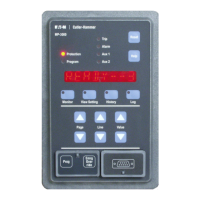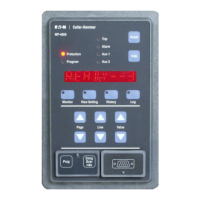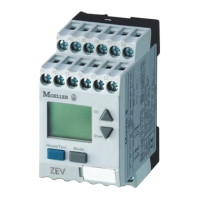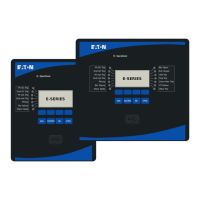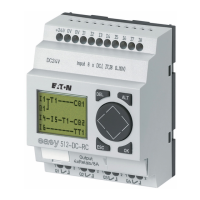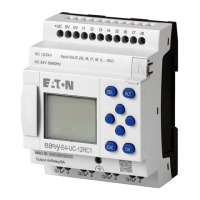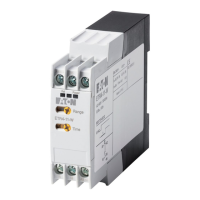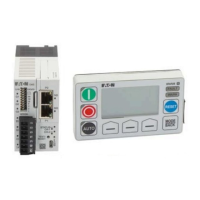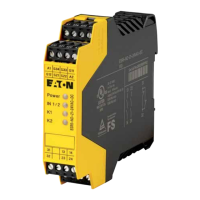For more information visit: www.cutler-hammer.eaton.com
Page 9-1
Effective 10/02 IL17562BH04
SECTION 9—APPLICATIONS AND SETTINGS
9.0 General
This section is a supplement to Section 5, giving more engineering
and application guidance for particular functions and settings.
Use this data in conjunction with Section 5 and Table 4.3, to develop
settings for the MP-3000, as well as making appropriate wiring design.
Note that particular settings are designated as PnLm, where Pn is the
page number and Lm is the line number of the particular setting in
Table 4.3, and in the page-line-value scheme of accessing settings on
the front panel of the MP-3000.
9.1 Motor Protection
The MP-3000 protects the motor, starter, and load in the following
ways:
• Stator and rotor thermal protection by modeling of heating and
cooling effects, including heating by negative sequence currents.
• Stator overtemperature protection by direct measurement (with
optional URTD module).
• Instantaneous overcurrent protection for faults.
• Ground fault protection.
• Phase reversal protection.
• Phase unbalance protection.
• Motor bearing and load bearing temperature protection (with
optional URTD module).
• Jam protection.
• Underload protection.
• Incomplete sequence protection (missing status feedback from
load).
• Trip-bypass output for failure of contactor to interrupt current after a
trip.
9.1.1 Thermal Modeling and Overload Protection without RTDs
Refer to Figure 9.1. The motor overload protection function, called the
I
2
T algorithm, calculates the rotor and stator temperature based on
effective heating current, integrated over time. Positive and negative
sequence current magnitudes are calculated in separate accurate
algorithms. The effective heating current is the sum of the positive and
negative sequence currents, with a heavy weighting factor on the
negative sequence contribution. This models the disproportionate
rotor heating effect of the negative sequence current (see Motor
Thermal Protection Basics, Section 8). Certain harmonic currents such
as the 5
th
and 11
th
also produce the same heating effects as fundamen-
tal-frequency negative sequence current; this harmonic heating effect
is also measured and modeled.
The temperature rise caused by current flow is modeled with a thermal
accumulator or bucket whose size or capacity is derived from motor
nameplate data entered as settings. The flow of effective heating
current into the bucket causes it to fill. Cooling is modeled by a
gradual emptying of the bucket. The settings which influence the
heating and cooling models are:
• Full-load amperes (FLA, P1L1)
• Locked-rotor current (LRC, P1L2)
• Maximum allowable stall or locked-rotor time (LRT, P1L3)
• Ultimate trip current (UTC, P1L4), which is usually service factor
times 100 percent.
The MP-3000 thermal bucket fills and proceeds towards a trip only
when the effective heating current is above the ultimate trip current
setting, P1L4. The modeling is based on an ambient temperature of 40
degrees C. A programmable I2T alarm I2TA, P4L2 informs the user
when the bucket reaches the user-set level between 60 percent and
100 percent full.
Without manual process load reduction, automatic process load
shedding (see 9.1.5), or other remedial action after an alarm, the relay
eventually trips and displays the message LRC/I2T (Locked Rotor/
Thermal Overload). The trip contact blocks motor restarting until the
temperature, as reflected in the thermal accumulator bucket level,
cools below the alarm level setting I2TA, P4L2.
NOTE: If stator RTDs are not used and the ambient may rise above 40
degrees C, the ultimate trip current should be set below that
indicated by the nameplate service factor to avoid stator
insulation damage or loss of life.
9.1.2 Overload Protection with RTDs
Connect from one to six stator RTDs to the optional URTD module,
and connect the URTD data communications output to the MP-3000
using an optical fiber (recommended) or wired connection. The MP-
3000 can then perform enhanced motor protection in two ways:
1. Direct measurements of the winding temperature are checked
against user-programmed alarm and trip temperature settings.
2. The thermal modeling combines the measured temperature with
the effective heating current and the motor constants to more
accurately model cooling as a function of temperature (more heat
is dissipated as the temperature rises). Loadability of the motor is
much improved.
If more than one RTD is connected, the hottest of up to six stator RTD
temperature measurements is used for protection. Note that motor
bearing, load bearing, and auxiliary RTD inputs are ignored by the
motor thermal algorithm. These other RTD inputs have their own alarm
and trip settings.
If stator temperature measurements are available, the algorithm may
restrain from tripping even if the effective current is above the ultimate
trip current setting, depending on stator temperature reports. It is still
important to set a correct ultimate trip current, so that the motor is well
protected if the RTDs, the module, or its communications to the relay
fail - the algorithm falls back to use of UTC. Also, note that if the
winding trip temperature WD T is set to OFF, the algorithm reverts to
the non-RTD calculation which is based strictly on UTC.
NOTE: Many users have the false impression that connecting RTDs
makes the motor relay more conservative and more likely to trip
under heavy load conditions. The reverse is actually true—use
of RTDs greatly increases motor loadability. With RTD
measurements, the MP-3000 is able to allow the motor to
operate safely with significantly higher sustained levels of
loading at normal ambient temperatures. Along with this, it can
effectively protect the motor when the ambient rises to any
level above 40 degrees C. See 9.1.4 below.
9.1.3 Protection Curve
Refer to the example of Figure 9.2. The motor protection curve
defines the current versus time limit that the MP-3000 develops from
programmed setting values. Ideally, this curve is located as close as
possible to the motor damage curve for maximum utilization of the
